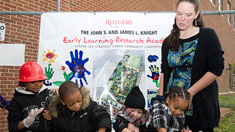ASSESSMENT PURPOSE & APPROACH
Key Questions
This second report in a three-year evaluation focuses on the 65 grants active in 2006 and addresses the following questions:
-
How can these grants across communities be categorized into common goals and strategies?
-
Which grants are making a difference in their communities, and how?
-
Who is being served by these grants, and in what ways?
Approach: This second report in a three-year evaluation estimating community impact, promoting cross-community learning and highlighting successes and challenges focuses on the 65 grants active in 2006. Insights are based primarily upon interviews with program officers, grantees, and the external evaluators who are working with those grantees, and upon a review of written reports submitted by grantees during 2006.
Assessment Partners: This report was produced by Deanna S. Gomby, Ph.D., and Lisa G. Klein, Ph.D..
PROJECT FINDINGS
-
Update on Knight’s Early Childhood Investments – As a result of a 2005 focus on strategic planning, program officers report that early childhood grantmaking will no longer remain a primary effort. Though some new grants have been made, 44 percent of open grants are scheduled to close in 2007.
-
Breakdown of Grants and Clusters – To formulate appropriate strategies, grants were categorized, with lessons learned by grantees, evaluators and program officers serving as a main focus for each. Clusters include mental health, dental health, parent education/parent involvement, early childhood education and systems change.
-
Quality Improvement in Centers – Grantees have begun investing in workforce development to offer everything from training via non-credit-bearing workshops to college coursework and technical assistance, curriculum implementation to introduce new, more effective instructional styles and child outcomes that assess change in children.
-
Systems Change – 11 grantees’ projects were designed to increase coordination across multiple service systems or across a single system. This was done at a scale that, if successful can change the lives of most children and families in the community.
-
Sustainability and Leveraging Funding – Grantees cite Knight support as being crucial in establishing new public-private partnerships. Some, however, have gone beyond securing resources and aim to change their funding landscape by involving public and private leaders in their community to design and solicit new public revenues.
-
Institutionalizing Change – Several programs have been so successful in meeting goals that their strategies have been adopted in whole or in part by other agencies that are now taking on the responsibility of their operations. In some cases, projects have even been commissioned for replication throughout the community.
